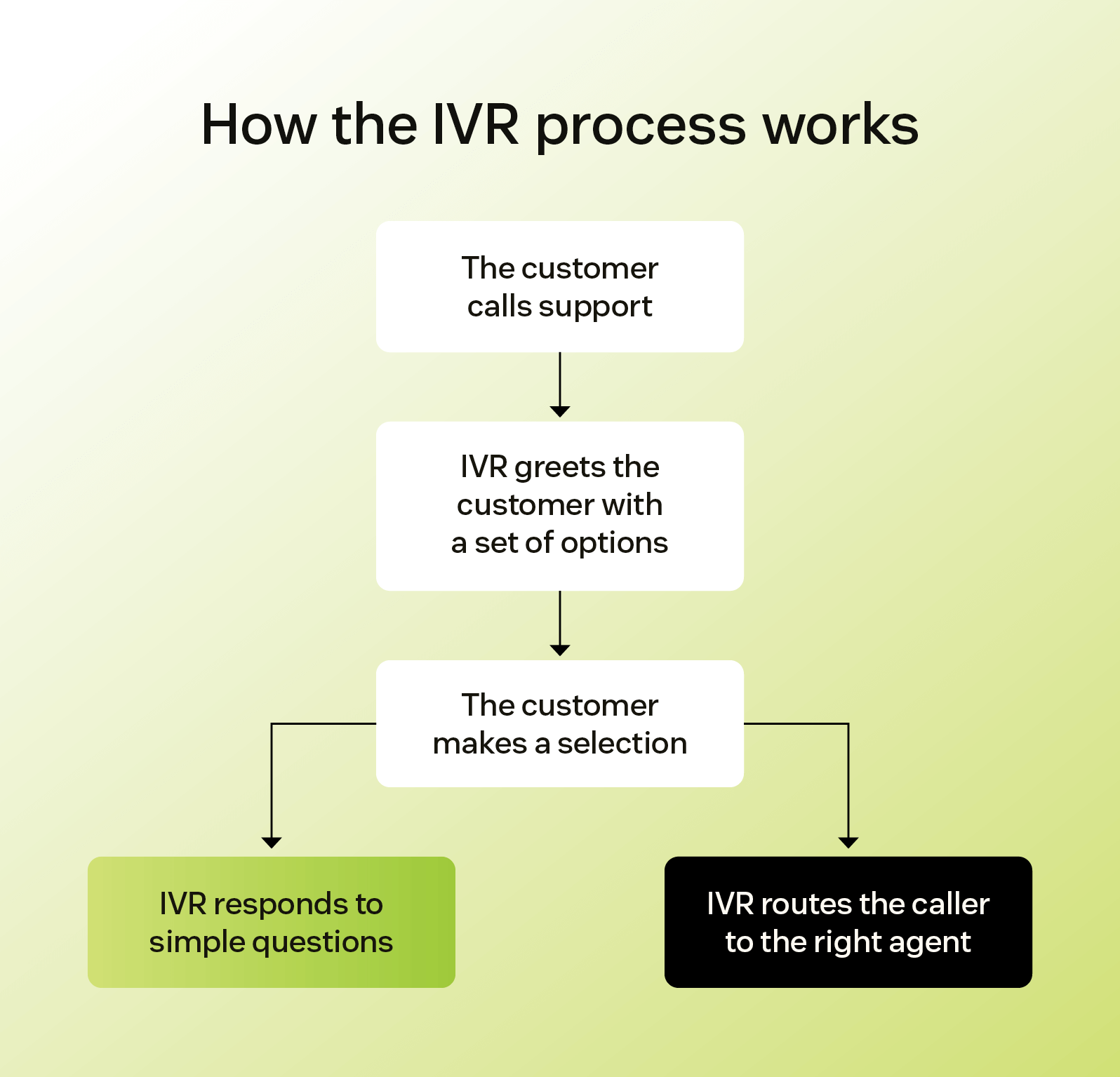Article
What is interactive voice response (IVR)? A complete guide
IVR technology can significantly enhance customer interactions and operational efficiency. Discover what an IVR system is and how it improves phone support.
Última actualización en August 11, 2025
What is IVR?Interactive voice response (IVR) is an automated phone system that greets callers, provides menu options, and directs them to the appropriate resource or action. |
You’ve likely encountered IVR more times than you can count. Short for interactive voice response, IVR refers to those familiar “press one for customer service, press two for returns” systems that have been a staple on business phone lines for years. While some organizations create frustrating IVR prompts, those that get it right lead to faster customer response times and greater efficiency for call center teams.
IVR helps call centers deflect incoming calls, answer customer questions immediately, and free up agents to handle urgent, complicated matters. In this guide, we’ll detail the benefits of IVR and how you can use it to provide more efficient service to your callers.
More in this guide:
- How does interactive voice response work?
- Types of IVR systems
- Challenges of interactive voice response
- IVR use cases
- Software related to IVR
- Frequently asked questions
- Enhance your IVR capabilities with Zendesk
How does interactive voice response work?
Interactive voice response combines telephony with automation, allowing computers to interact directly with telephone systems through computer-telephony integration (CTI). This enables automated call handling over traditional public switched telephone networks (PSTN) and modern voice over IP (VoIP) networks.
An IVR system typically includes an application server, which hosts the IVR software, and databases that store necessary interaction information.
In simple terms, IVR guides customers using pre-recorded prompts or menu options. You can use a touch-tone keypad or, with more advanced systems, voice recognition technology that understands spoken commands. This allows customers to reach the proper department or support agent, or to self-serve effectively.
Alt text: A flow chart shows how the IVR process works from end-to-end.
Here’s a typical IVR interaction flow:
A customer calls your support number.
The IVR greets them and offers a menu of choices, such as “Press 1 for billing” or “Press 2 for technical support.”
The caller responds using their keypad or voice commands.
Based on that input, the system may transfer them to the appropriate team member, respond with pre-recorded information, initiate a callback, or switch the interaction to SMS for added convenience.
IVR empowers businesses to engage in better call center management by optimizing call routing and helping employees efficiently manage their time. This helps customers get to where they need to go faster and can improve the customer experience (CX).
|
Types of IVR systems
IVR systems have evolved to offer different levels of interaction. Here are the common IVR types.
- Touch-tone IVR: This is the most basic form, where customers navigate menus by pressing numbers on their phone keypad. Each key press sends a Dual-Tone Multi-Frequency (DTMF) signal that the IVR system interprets.
- Directed dialog IVR: This type guides callers through specific, predefined questions and options, prompting them to say or select from a limited set of choices.
- Natural language processing (NLP) IVR: More advanced systems use NLP and conversational AI to understand and respond to free-form speech. This allows for more intuitive and human-like interactions, as the system can interpret a caller’s intent even if they don’t use exact phrases.
Well-integrated IVR systems go beyond basic routing. They optimize operations, personalize support experiences, and help businesses scale their support.
The benefits of using IVR
Customers have increasingly high standards for support. Luckily, contact centers can use an IVR phone system to meet buyers’ evolving needs and expectations. Let’s take a look at how IVR enhances the support experience for customers and internal teams.
Reduces operational costs
Operational costs can be reduced with interactive voice response systems, as they automate repetitive tasks, deflect incoming calls, and streamline workflows. Providing customers access to automated self-service options means fewer tickets for agents to handle, which helps shorten response times. Businesses that track IVR data can uncover additional efficiencies, like optimizing menu paths or reducing average call duration.
Tip: Regularly review customer feedback and analyze IVR call data like call deflection rate, completion rate, and abandonment rate to improve performance for an exceptional CX. |
Provides 24/7 support
Providing around-the-clock support is a key aspect of good customer service. However, not every inbound call center can offer live, 24/7 support.
With IVR customer service, you can use pre-recorded responses to common questions, such as listing standard business operating hours or holiday schedules. An IVR call center can also give customers access to automated transactions like making payments, checking account balances, or scheduling a call back from a live agent. These features can provide flexibility and convenience.
Tip:Create IVR scripts in advance for anticipated questions related to holiday closures, hours of operation, and limited-time offers to ensure callers stay informed. |
Improves smarter call routing and triage
Customers expect fast, personalized service, and only one negative interaction can lead them to look elsewhere. With IVR, you can ensure important callers, like high-value customers, are prioritized and routed to the most appropriate agent quickly.
Some of the top benefits of IVR call routing and triage include the ability to:
Prioritize calls from VIPs and high-value customers.
- Route callers to specific agents or departments based on their area codes, priority, customer sentiment, intent, and language.
See customer tickets waiting in the queue.
Run triggers to adjust the call priority or routing destination when a new customer queues.
Send callers to the first available agent.
Tip: Use historical data and customer tags to automatically prioritize key accounts and reduce friction for repeat callers. |
Increases first contact resolutions

When customers are routed correctly and can access the information they need right away, first resolution rates (FCR) improve while frustration goes down. IVR achieves this by directing calls to the most relevant team or using pre-recorded answers for routine questions.
Take it from fabric and quilting retailer Missouri Star Quilt Company: After implementing Zendesk IVR and skills-based routing to handle its growing call volume, they achieved a 95 percent call answer rate and a 97 percent customer satisfaction score.
Tip: Set up your IVR menu options so customers get routed to the department with the expertise needed to resolve their issue the first time. |
Streamlines support workflows
During peak hours or periods of high call volume, IVR software keeps your team from getting overwhelmed. It manages queue logic, deflects routine questions, and offers options like callbacks or SMS, reducing wait times and boosting agent productivity.
Here are a few ways IVR helps businesses streamline workflows:
- Callback options or voicemail: Offer customers the ability to request a callback or leave a message when wait times are long.
- Intelligent call routing: Automatically forward calls to a specific line or department when specialized expertise is needed.
- Additional IVR layers: Present follow-up menus or recorded info that guides customers to online resources or further options.
- SMS handoff: Transition the interaction to text so customers can get assistance or links to resources without staying on hold.
- Answer FAQs: Answer frequently asked questions automatically with prerecorded messages and links to help center articles.
- AI-powered quality assurance (QA): Automatically monitor call center performance in real time, identify customer churn risk, and make informed decisions to improve your customer support.
Tip: Always offer a live support or callback option when self-service isn’t enough. This prioritized CX by balancing automation with accessibility. |
Improves data and analytics
IVR systems for call centers are valuable sources of insight. They track everything from customer intent and choices to wait times and drop-off points, giving teams the data to refine the experience.
You can use IVR analytics to:
Optimize menu structures and prompts.
Identify points of friction or high drop-off.
Track performance across departments.
Train agents based on common call drivers.
IVR insights also contribute to broader call center metrics, helping you evaluate performance and make more informed decisions.
Tip: Review IVR reporting and analytics regularly and adjust flows based on patterns in usage, abandonment, or missed intent. |
Enhances security
IVR can support secure transactions by verifying customer identities before moving forward. Systems can request PINs and account numbers or even use voice biometrics for authentication.
Some use cases include:
Balancing inquiries or fund transfers in finance
Securing payments via IVR prompts
Verifying personal details before routing sensitive inquiries
Tip: Layer in authentication early in the IVR process to reduce risk and protect customer data. |
Challenges of interactive voice response
While IVR offers powerful benefits, poor implementation can frustrate customers. Below, we highlight common IVR challenges and some call center tips you can use to overcome them.
- Lack of human touch: Automated systems can feel impersonal, especially when customers have urgent or emotional issues.
Solution: Use friendly, natural voice recordings and give callers a clear path to live agents when needed. |
- Complex menu and navigation: Too many options or unclear instructions can lead to frustration, dropped calls, or even create an angry customer.
Solution: Keep menus concise and intuitive and use customer data to personalize options when possible. |
- Speech recognition issues: If IVR can’t understand customers, or they aren’t sure how to respond, it disrupts the entire interaction.
Solution: Pair speech recognition with keypad alternatives. Train NLP models continuously and use clear instructions to reduce errors. |
IVR use cases
IVR is a flexible solution that can be tailored to fit organizations across industries. Whether you’re in retail, healthcare, or education, it offers scalable ways to manage customer support and automate service delivery. Here are a few examples:
- Retail and e-commerce: Automates order status updates, product inquiries, and returns through self-service phone menus.
- Finance: Offers secure access to account balances, recent transactions, and fund transfers over the phone.
- Healthcare: Helps patients schedule appointments, refill prescriptions, or receive general medical info without waiting on hold.
- Education: Allows students and parents to check class schedules, test results, or administrative updates through automated voice menus.
- Telecommunications: IVR assists with managing plan changes, guiding customers through technical troubleshooting, providing usage updates, allowing subscribers to pay bills, and enhancing support and customer self-service for common inquiries.
- Travel and hospitality: Enables guests to confirm bookings, check flight or reservation status, request room service, or receive travel alerts, without speaking to an agent.
Software related to IVR
IVR is a powerful tool on its own, but it becomes even more effective when integrated with other customer support technologies. These tools complement IVR to automate support, deflect tickets, and provide always-on service, creating a more seamless and efficient customer experience.
- Voice software: Voice software is a solution that often includes IVR and can help businesses interact with customers over the phone, voicemail, and text. Some systems have an omnichannel focus, meaning support agents can reference consumer information across channels as they speak with them.
- AI agents: AI agents are advanced bots that can autonomously handle customer concerns over any digital channel, like live chat, SMS, and social messaging. They can offer 24/7 support, execute tasks like product refunds from start to finish, and provide instant, accurate, and personalized responses for even the most complex customer requests. Learn more about Zendesk AI agents.
- AI-powered knowledge bases: AI-powered knowledge bases are advanced solutions that can help your customers self-serve, reducing the need for them to contact human support. This software enables you to create and manage helpful content like how-to articles, product guides, and FAQ pages. You can also connect the system to AI agents, which can surface them to customers during support interactions.
- Voice AI: Voice AI allows organizations to establish AI call centers. This technology can empower businesses to answer customer calls with AI agents, help them identify churn risks and outliers with QA, and provide transcripts and summaries after the call.
Frequently asked questions
Enhance your IVR capabilities with Zendesk
With the right IVR solution, your business can provide a powerful automated system that helps streamline workflows and keep ticket queues manageable.
With Zendesk, you can stay dialed in with your customers and expertly deliver omnichannel service. Our voice capabilities are fast to set up and come with powerful AI capabilities that can help you resolve calls with automation, monitor quality, and direct and route calls from the same workspace.
Learn more about how Zendesk can upgrade your IVR capabilities.

